AWS Certified Developer - Associate
Serverless Application Model SAM
SAM Advanced Demo
In this article, we walk you through an advanced example of using the AWS SAM CLI to build, deploy, and test a serverless application. We will guide you from initializing a new SAM project to deploying a fully functional API integrated with DynamoDB, using multiple Lambda functions.
Project Initialization
To begin, open your terminal and execute the following command to initialize your SAM project:
C:\Users\sanje\OneDrive\Documents\courses-sanjeev-desktop\aws-developer-associate\SAM-Advanced>sam init
During initialization, the CLI prompts a series of questions to configure your project. AWS offers several Quick Start templates, such as the simple Hello World example, data processing workflows, serverless APIs, DynamoDB integrations, and machine learning samples. For this demo, choose the simple "Hello World" template.
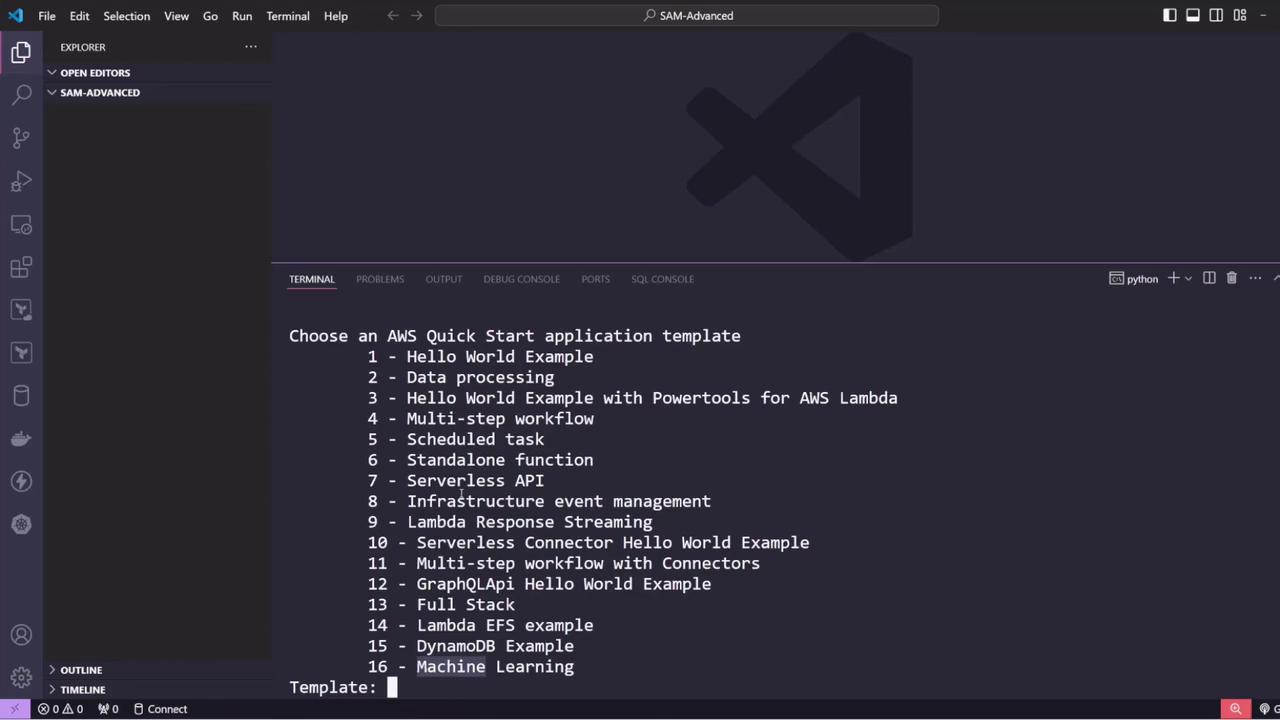
Next, select your desired runtime. Even though Python is typically the default, this example uses Node.js (e.g., Node.js 20). Choose the zip package type and plain JavaScript.
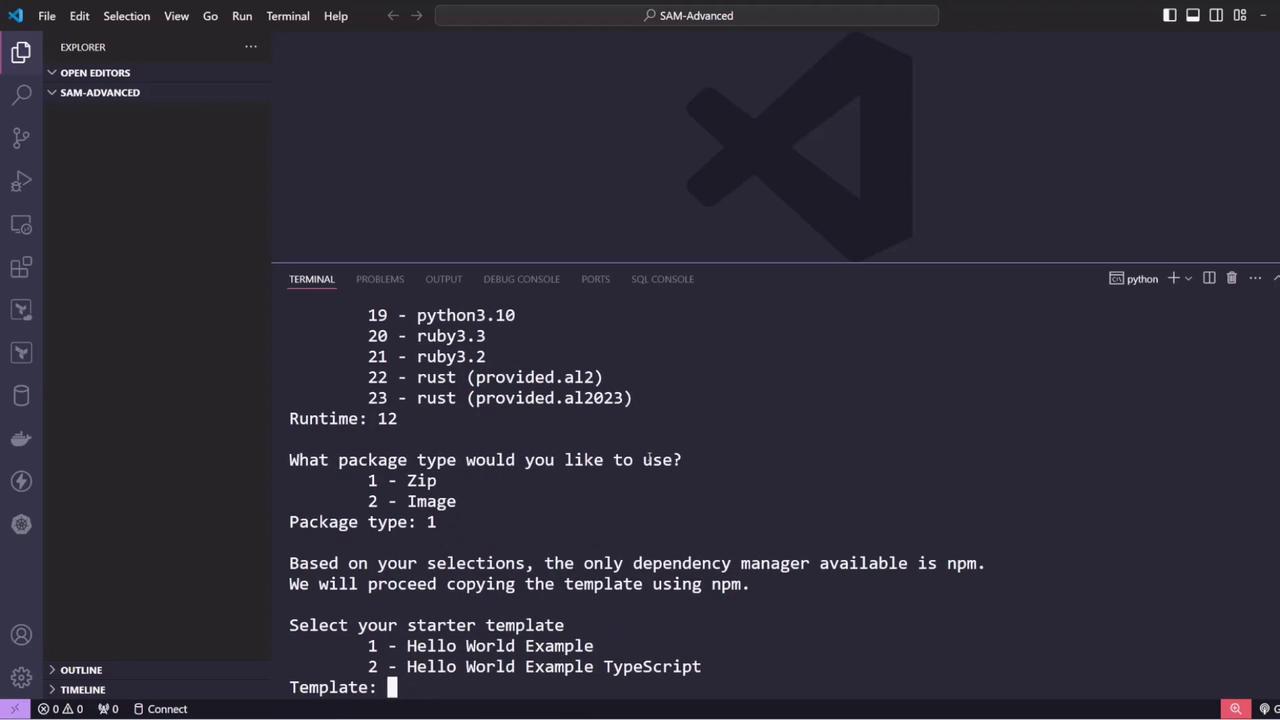
The CLI then asks if you want to enable additional features such as X-Ray tracing or CloudWatch monitoring. For simplicity, answer "no" for these options and provide a project name, for example, "SAM API."
After confirmation, SAM creates the project folder structure along with essential files. You might see an output similar to:
Commands you can use next
===========================
[*] Create pipeline: cd sam-api && sam pipeline init --bootstrap
[*] Validate SAM template: cd sam-api && sam validate
[*] Test Function in the Cloud: cd sam-api && sam sync --stack-name {stack-name} --watch
Project Structure and Configuration
The generated project includes a template.yaml file that defines your SAM configuration. Key sections include a project description, global function settings (like the default function timeout), and resource definitions. Below is an excerpt of the template showcasing the Hello World function:
Description: >
Sample SAM Template for sam-api
Globals:
Function:
Timeout: 3
Resources:
HelloWorldFunction:
Type: AWS::Serverless::Function # More info: https://github.com/awslabs/serverless-application-model/blob/master/versions/2016-10-31.md#awsserverlessfunction
Properties:
...
The API event for the Hello World function is defined as shown below:
Resources:
HelloWorldFunction:
Properties:
Events:
Api:
Type: Api # More info: https://github.com/awslabs/serverless-application-model/blob/master/versions/2016-10-31.md#api
Properties:
Path: /hello
Method: get
Outputs:
# ServerlessRestApi is an implicit API created out of the Events key under Serverless::Function
Other files generated include a README, a .gitignore, sample tests, and directories for Lambda function code and test events. For instance, here is a Node.js Lambda function snippet:
export const lambdaHandler = async (event, context) => {
const response = {
statusCode: 200,
body: JSON.stringify({
message: 'hello world',
})
};
return response;
};
A sample event JSON file for local testing looks like:
{
"requestContext": {
"accountId": "123456789012",
"resourceId": "123456",
"stage": "prod",
"requestId": "c6af9ac6-7b61-11e6-9a41-93e8deadbeef",
"requestTime": "09/Apr/2015:12:34:56 +0000",
"requestTimeEpoch": 1428582896000,
"identity": {
"sourceIp": "127.0.0.1"
}
}
}
Similarly, an event simulating an API Gateway POST request is provided below:
{
"body": "{\"message\":\"hello world\"}",
"resource": "/{proxy+}",
"path": "/path/to/resource",
"httpMethod": "POST",
"isBase64Encoded": false,
"queryStringParameters": {
"foo": "bar"
},
"pathParameters": {
"proxy": "/path/to/resource"
},
"stageVariables": {
"baz": "qux"
}
}
Once your application setup is complete, deploy it using:
C:\Users\sanje\OneDrive\Documents\courses-sanjeev-desktop\aws-developer-associate\SAM-Advanced>sam deploy
Evolving the Example: Building an API for an E-Commerce Application
In this section, we extend the project to create an API for an e-commerce (or inventory) application. The API will allow users to add new products and retrieve a list of existing products from a DynamoDB table.
Start by cleaning up any unnecessary files (like tests, .npmignore, and package.json) and reorganize your project structure so that all Lambda functions reside within a dedicated source folder.
Next, add several Lambda functions to the project:
- Create Products – Adds a new product to the DynamoDB table.
- Get All Products – Retrieves the complete list of products.
- Get Product by ID – Retrieves a specific product by its name (used as the primary key).
Create Products Lambda Function
Below is the Lambda function code snippet for creating products:
import { DynamoDBClient } from "@aws-sdk/client-dynamodb";
import { DynamoDBDocumentClient, PutCommand } from "@aws-sdk/lib-dynamodb";
const client = new DynamoDBClient({});
const ddbDocClient = DynamoDBDocumentClient.from(client);
// Get the DynamoDB table name from environment variables
const tableName = process.env.TABLE;
/**
* A simple example includes an HTTP POST method to add one item to a DynamoDB table.
*/
export const createProductsHandler = async (event) => {
if (event.httpMethod !== "POST") {
throw new Error(`postMethod only accepts POST method, you tried: ${event.httpMethod}`);
}
// Add logic to put the item into DynamoDB using ddbDocClient and PutCommand
};
The corresponding SAM resource definition in template.yaml is provided below:
Globals:
Function:
Timeout: 3
Resources:
ProductsTable:
Type: AWS::Serverless::SimpleTable
Properties:
PrimaryKey:
Name: name
Type: String
createProduct:
Type: AWS::Serverless::Function
Properties:
Handler: src/create-products.createProductsHandler
Runtime: nodejs20.x
Architectures:
- x86_64
Environment:
Variables:
TABLE: !Ref ProductsTable
Policies:
- DynamoDBCrudPolicy:
TableName: !Ref ProductsTable
Events:
Api:
Type: Api
Properties:
Path: /products
Method: POST
Note
The policy template (DynamoDBCrudPolicy) automatically grants the necessary CRUD permissions on the specified DynamoDB table to the Lambda function.
Deploying the API
After configuring your Lambda function and API event, deploy the stack using the guided deployment command:
C:\Users\sanje\OneDrive\Documents\courses-sanjeev-desktop\aws-developer-associate\SAM-Advanced\sam-api>sam deploy --guided
Follow the interactive prompts to configure deployment parameters such as stack name, region, and IAM role confirmations. After deployment, CloudFormation creates the DynamoDB table, API Gateway, Lambda functions, and assigns the required permissions.
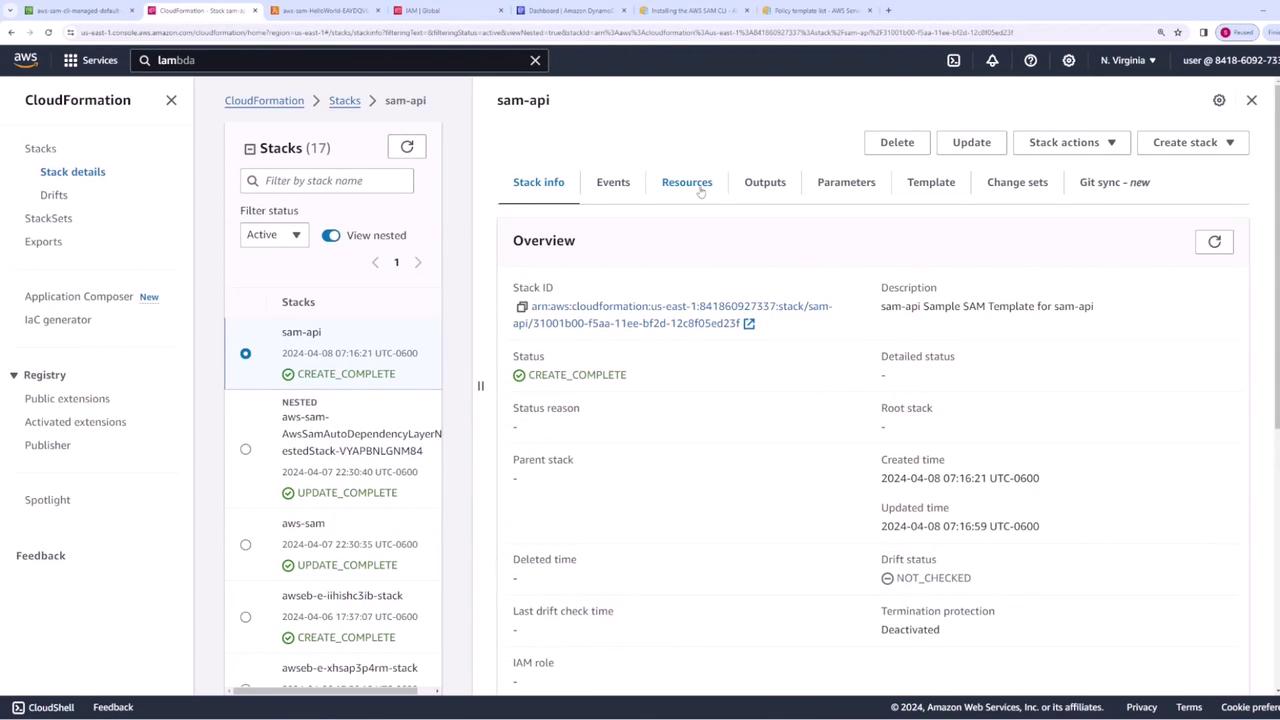
Verify the deployed resources in your AWS Console:
- DynamoDB: Check the products table.
- Lambda: Confirm the createProduct Lambda function.
- API Gateway: Ensure that the API properly triggers your Lambda functions.
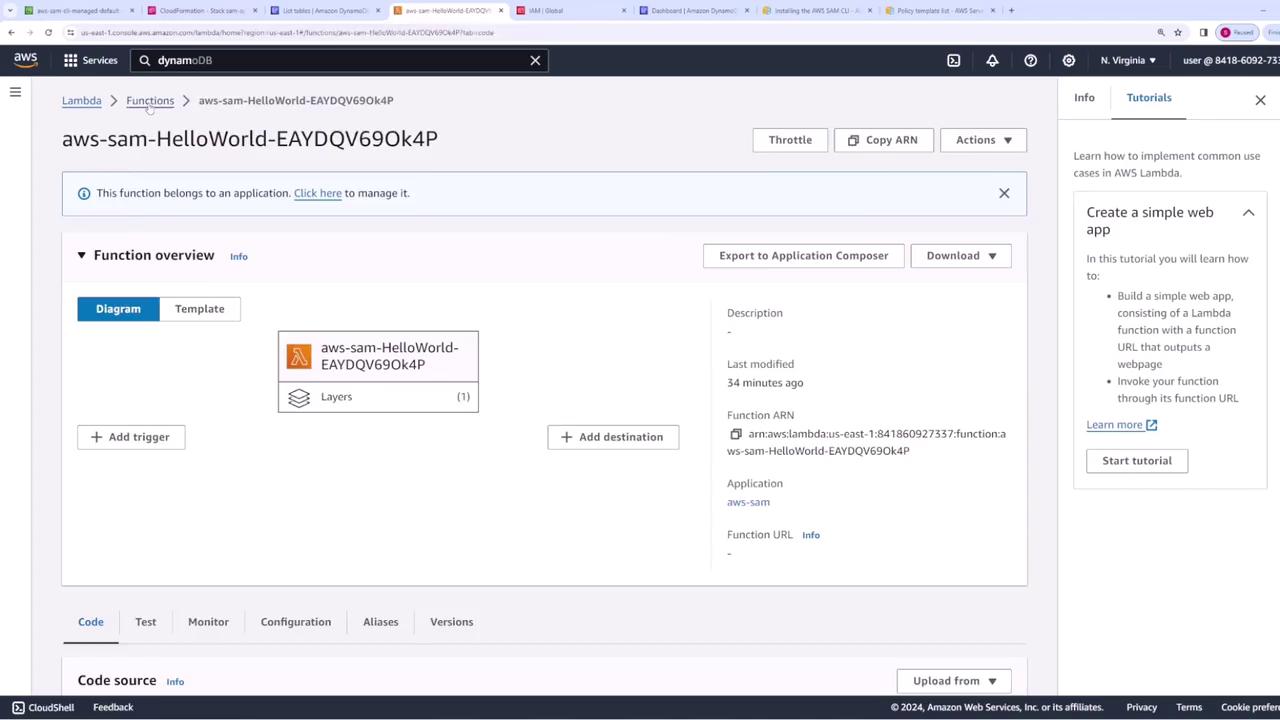
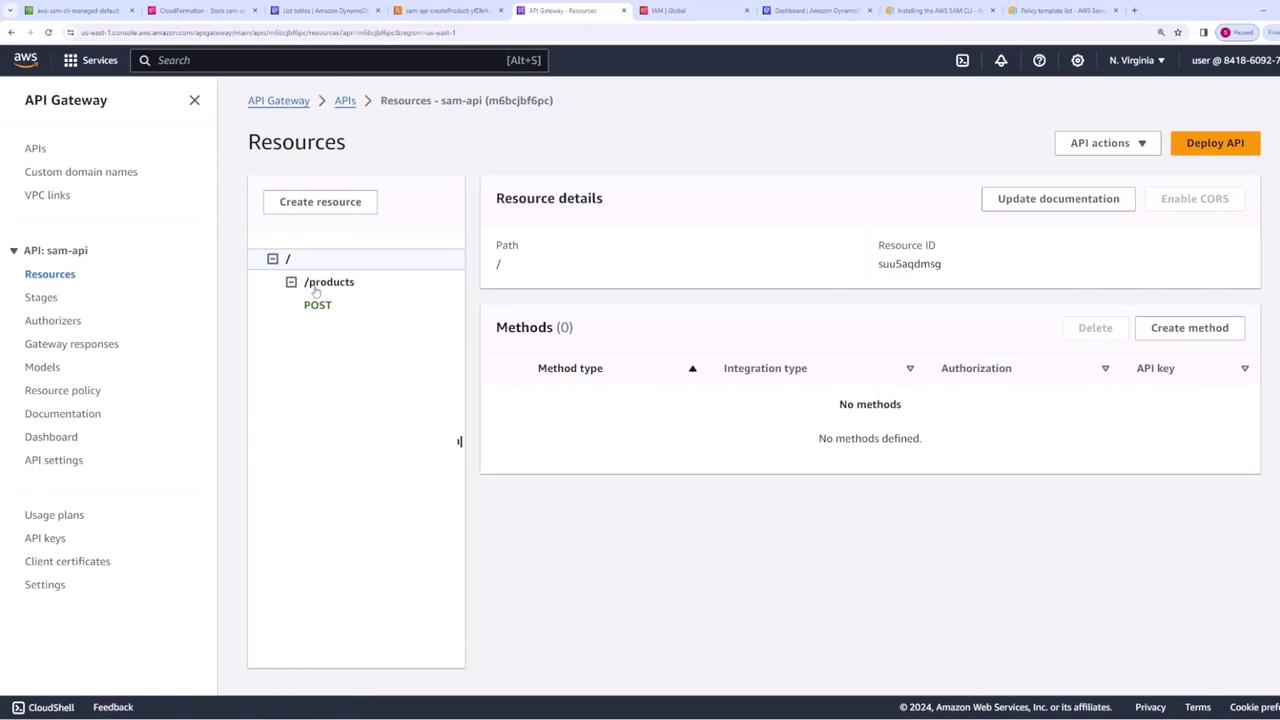
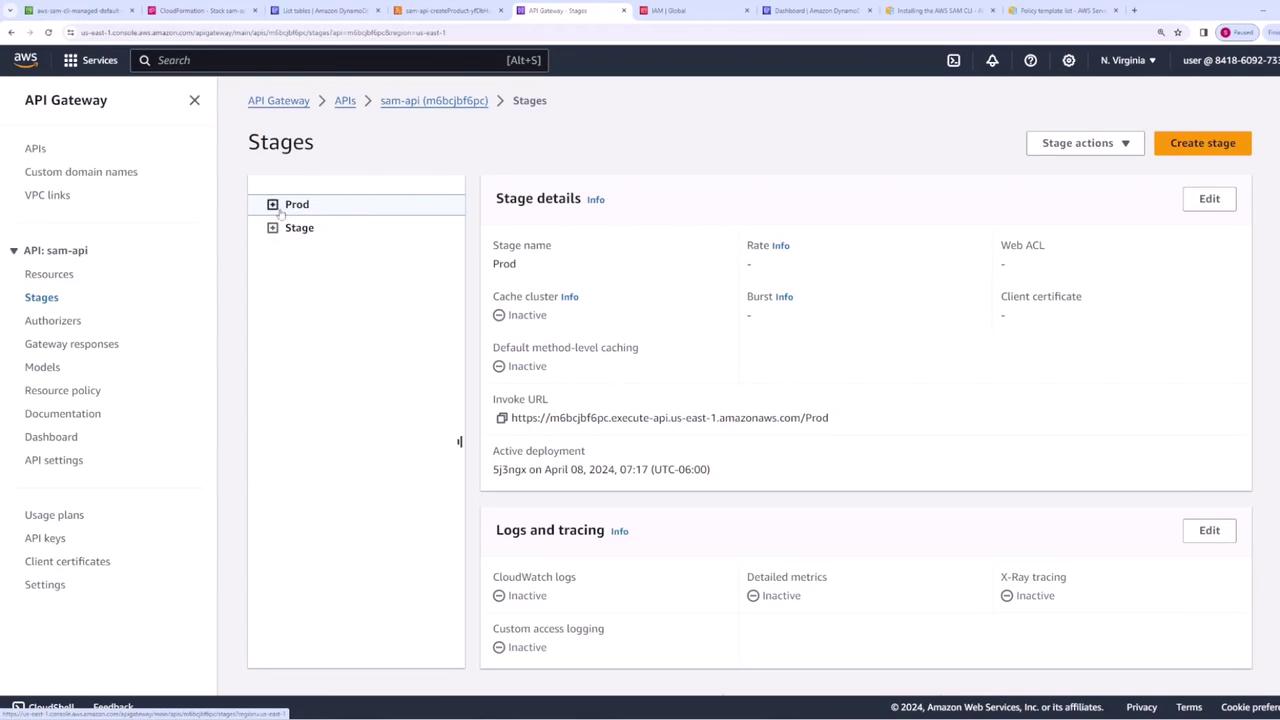
Testing the API
Use tools like Postman or curl to test your API endpoints. For instance, to create a new product, send a POST request with a JSON payload containing the required "name" field along with additional properties such as price.
Example POST payload for creating a phone:
{
"name": "phone",
"price": 200
}
After adding multiple products (e.g., phone, TV, book), inspect the DynamoDB table to verify the entries.
For the Get All Products endpoint, configure a Lambda function in your template as follows:
Resources:
getAllProducts:
Type: AWS::Serverless::Function
Properties:
Handler: src/get-all-products.getAllProductsHandler
Runtime: nodejs20.x
Architectures:
- x86_64
Policies:
- DynamoDBCrudPolicy:
TableName: !Ref ProductsTable
Environment:
Variables:
TABLE: !Ref ProductsTable
Events:
Api:
Type: Api
Properties:
Path: /products
Method: GET
Similarly, set up the Get Product by ID endpoint (using the product name as a path parameter) with the following configuration:
Resources:
getProductById:
Type: AWS::Serverless::Function
Properties:
Handler: src/get-product-by-id.getProductByIdHandler
Runtime: nodejs20.x
Architectures:
- x86_64
Policies:
- DynamoDBCrudPolicy:
TableName: !Ref ProductsTable
Environment:
Variables:
TABLE: !Ref ProductsTable
Events:
Api:
Type: Api
Properties:
Path: /products/{name}
Method: GET
Deploy your updated template with:
sam deploy
Test the endpoints by sending:
- A GET request to
/productsto retrieve all products. - A GET request to
/products/{name}(for example,/products/book) to retrieve a single product.
Example response for /products:
[
{
"name": "book",
"price": 25
},
{
"name": "phone",
"price": 200
},
{
"name": "tv",
"price": 400
}
]
Example response for /products/book:
{
"name": "book",
"price": 25
}
Outputting API Information
To simplify testing and troubleshooting, add an Outputs section to your template.yaml to display useful details such as the Lambda ARN and the API URL:
Outputs:
createProductsFunction:
Description: "ARN of create products function"
Value: !GetAtt createProduct.Arn
APIUrl:
Description: "URL of the API"
Value: !Sub "https://${ServerlessRestApi}.execute-api.${AWS::Region}.amazonaws.com/Prod"
After running sam deploy, you will see output similar to:
Outputs
-------------------------------------------------
Key Description Value
createProductsFunction ARN of create products function arn:aws:lambda:us-east-1:841860927337:function:sam-api-createProduct
APIUrl URL of the API https://<api-id>.execute-api.us-east-1.amazonaws.com/Prod
Cleaning Up
Once testing is complete and you no longer need the deployed resources, clean up by deleting the CloudFormation stack:
sam delete
This command removes the stack along with all associated resources.
This concludes our SAM advanced demo. In this article, we covered how to initialize a SAM project using a Quick Start template, build and configure multiple Lambda functions integrated with DynamoDB and API Gateway, and output essential deployment information for testing. Happy coding!
Watch Video
Watch video content
Practice Lab
Practice lab